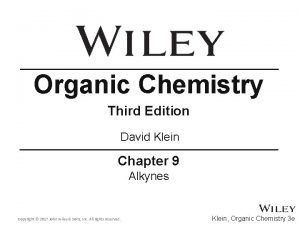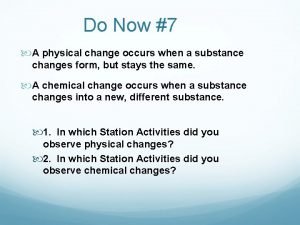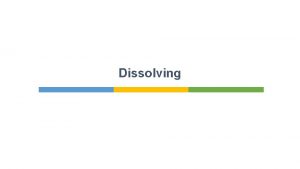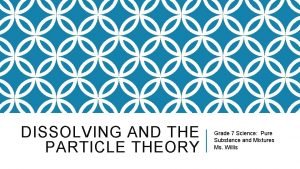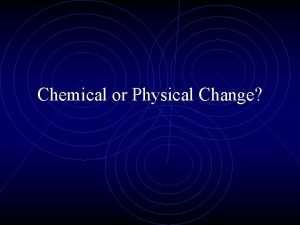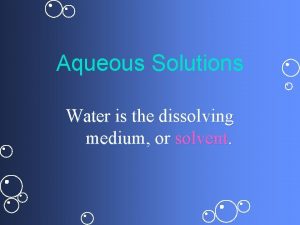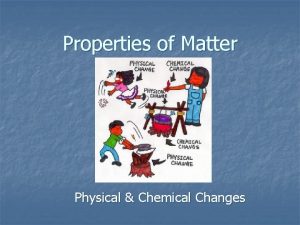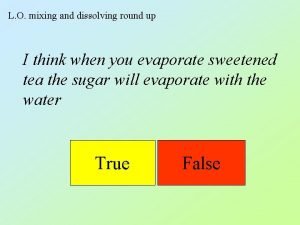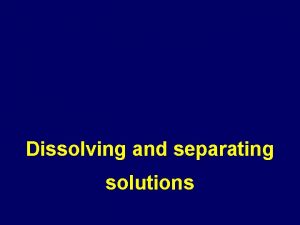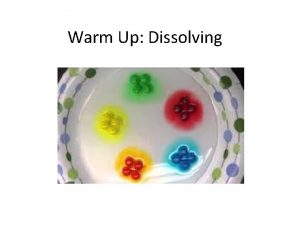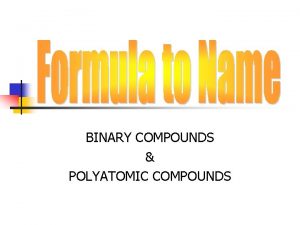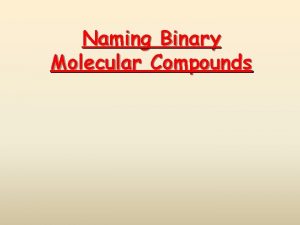8 3 The Dissolving Process Dissolving Compounds For










- Slides: 10

8. 3 The Dissolving Process

Dissolving Compounds • For a substance to dissolve, solute-solvent attractions must overcome the attractions within both solute and solvent. – Example: In order to dissolve, ionic bonds must be broken by water.

Dissolving Ionic Compounds • When ionic compounds are dissolved, water molecules reorient themselves such that their poles are oriented around oppositely charged ions. Ionic solutions conduct electricity – Free ions in solution

Dissolving Ionic Compounds • Hydration: the process in which ions are surrounded by water molecules • Dissociation: The process in which ions separate from ionic crystals, becoming individual ions. Na. Cl (s) Na+ (aq) + Cl- (aq) Na 2 CO 3 (s) 2 Na+ (aq) + CO 32 -(aq) Only ionic compounds undergo dissociation Water is not included as it does not undergo a chemical change

Writing Dissociation Equations Write dissociation equations for: – magnesium chloride – potassium phosphate – aluminum oxide – ammonium sulphate

Dissolving Molecular Compounds • Solubility of molecular compounds varies – glucose(C 6 H 12 O 6) and ethanol (C 2 H 5 OH) form solutions, while oil does not. • Miscible: liquids that can mix to form a solution – ie: alcohol and water • Immiscible: liquids that can not mix to form a solution – ie: oil and water

Dissolving Molecular Compounds • Water and ethanol both contain O-H bonds. • Both can form hydrogen bonds and form them with each other when they are mixed. • Attractive forced allow water and ethanol to mix to form an aqueous solution.

Like Dissolves Like • Ionic and polar compounds dissolve in polar solvents due to solute-solvent attractions. • Non-polar solutes do not dissolve in polar solvents – weak solute-solvent attractions • Non-polar solutes do dissolve in non-polar solvents. Oil and water do not mix!

Surfactants • Polar and non-polar compounds can be encouraged to mix using surfactants – aka detergents. • Detergents contain a long non-polar hydrocarbon chain attached to a polar head • The hydrocarbon chain latches onto non-polar compounds while the charged is attracted to water molecules

Homework Read: Section 8. 3 Questions: Page 389 # 6, 8, 9, 10, 15,
 Ionic vs covalent bonds venn diagram
Ionic vs covalent bonds venn diagram Reactions with alkynes
Reactions with alkynes Volume of a golf ball
Volume of a golf ball When does a physical change occur? *
When does a physical change occur? * Dissolving diagram
Dissolving diagram Using particle theory to explain dissolving
Using particle theory to explain dissolving Inflating a balloon physical or chemical change
Inflating a balloon physical or chemical change Dissolving medium
Dissolving medium Factors that affect dissolving
Factors that affect dissolving Physical and chemical properties
Physical and chemical properties Mixing and dissolving
Mixing and dissolving

